Tequila...the champagne of Mexico
Tequila, Mezcal, AGAVE SPIRITS, & MIXTOS, as it applies to the global consumer.
Tequila
Made 100% from the Weber blue agave, Tequila can only be produced in the state of Jalisco, Mexico, along with a few other municipalities in surrounding states (Guanajuato, Nayarit, Michoacan, and Tamaulipas) according to Mexican law. If made in any other region, or from any other variation of the agave plant, it’s not technically Tequila, even if it tastes just like it. Blanco or Plata Tequila is unaged and bottled immediately after distillation. Reposado Tequila must be aged in oak barrels at least 2 months but not longer than 1 year. Añejo Tequila is aged from 1-3 years in small oak barrels, while Extra Añejo must be aged for a minimum of 3 years.
MEZCAL
Unlike Tequila, Mezcal can be made from any of the 270+ species of agave plants grown around the world, but must only be produced in the Oaxaca, Guerrero, Durango, San Luis Potosí, Puebla and Zacatecas state of Mexico. Another differentiating characteristic is the smoky flavor of Mezcals, due to the piñas (the core of the agave) being smoked rather than steamed during preparation for fermentation. If you’ve ever seen a worm in a bottle of Tequila, it was actually a Mezcal!
Fun fact: Tequila is a type of Mezcal, but Mezcal is not a Tequila.
Agave Spirits
Agave Spirits are any spirit produced from any member of the Agave genus and can be produced anywhere in the world. This leads to a wide variety of flavors & quality bearing the Agave Spirit name, but there are some great ones out there.
Local tip: To taste a great Utah-based agave spirit, check out Rabbit and Grass from New World Distillery in Eden, Utah.
Mixtos
Mixtos is a result of blue agave shortages at Mexican farms throughout the recent past. Taking 7 to 14 years to mature to the point of harvest, agave plant supply has been tough to keep in line with market demands. To allow farmers to keep up supply with the growing global demand of Tequila, the Mexican government introduced the category of mixtos, allowing up to 49% of the sugars in the fermentation to come from non-agave sources, such as glucose or fructose. The result of this gets you the ABV you’re looking for, but also gives a taste different than you might want in a good Tequila.
Fear not, for the most part, a quick search of your label can help identify exactly what you’re looking for to verify the quality of Tequila you’ve purchased. As all bottled Tequila has to come from Mexico, if it says 100% Blue agave (Agave Azul), and has both a CRT & NOM (Norma Oficial Mexicana) icons, it has been certified.
Finally, a common trick some deceitful manufacturers use when producing pre-mixed drinks with Tequila is to supplement it with vodka to make the drink more cheaply. You can spot this when the ingredients on the front include “neutral spirits” along with the Tequila. Technically, this means they can just pour an ounce of Tequila into a giant tank and still be “accurate” in their ingredient labeling.
Here at Simplicity, we only use premium Tequila (along with just the right amount of Triple Sec and Lime) to craft a light, sweet, and delicious Cadillac Margarita. Check it out here.





